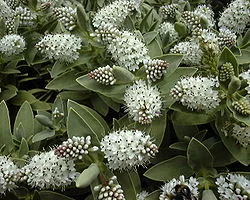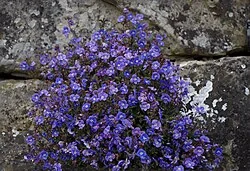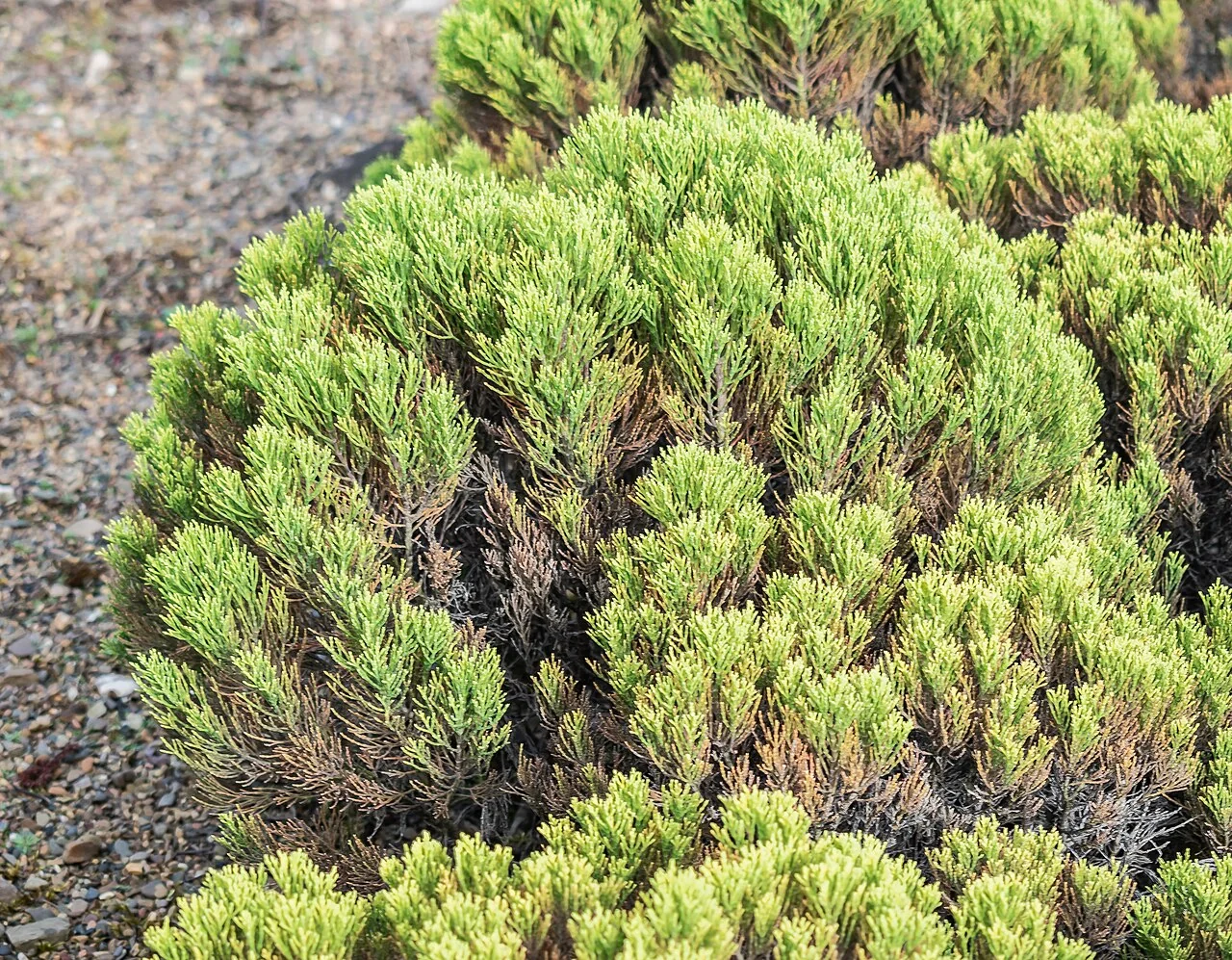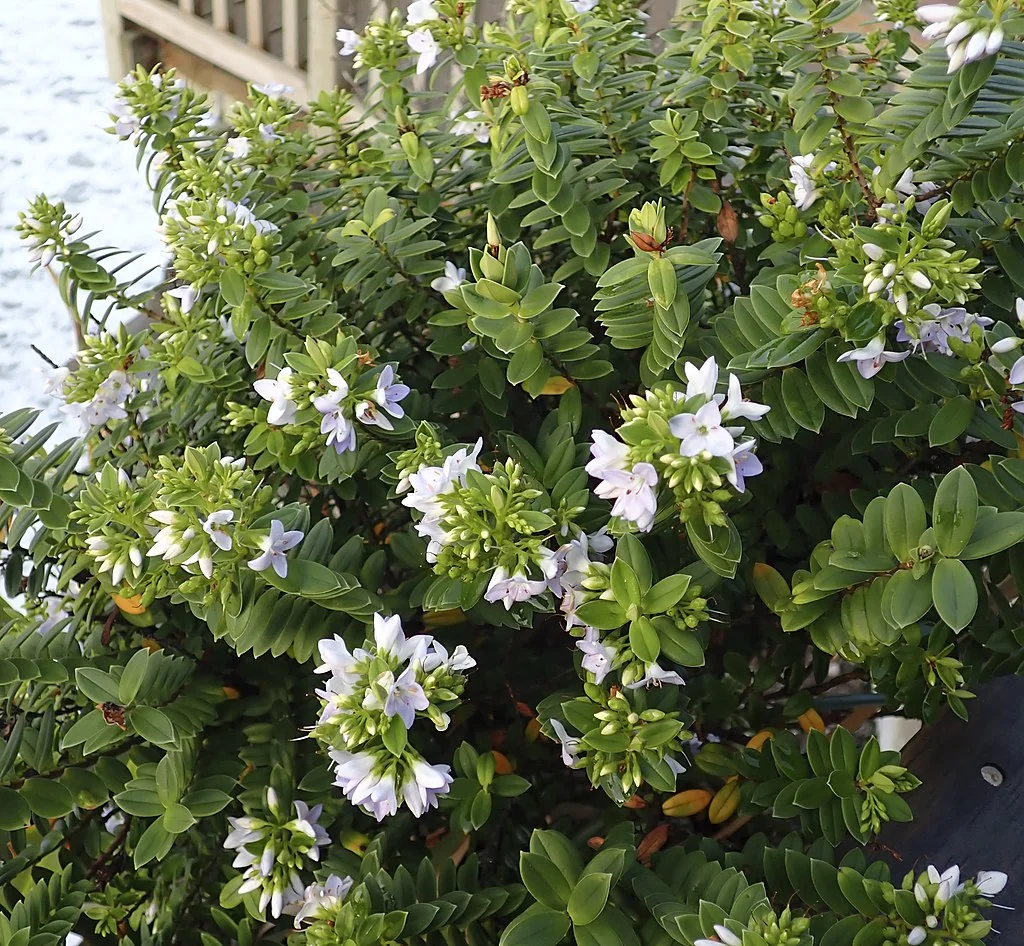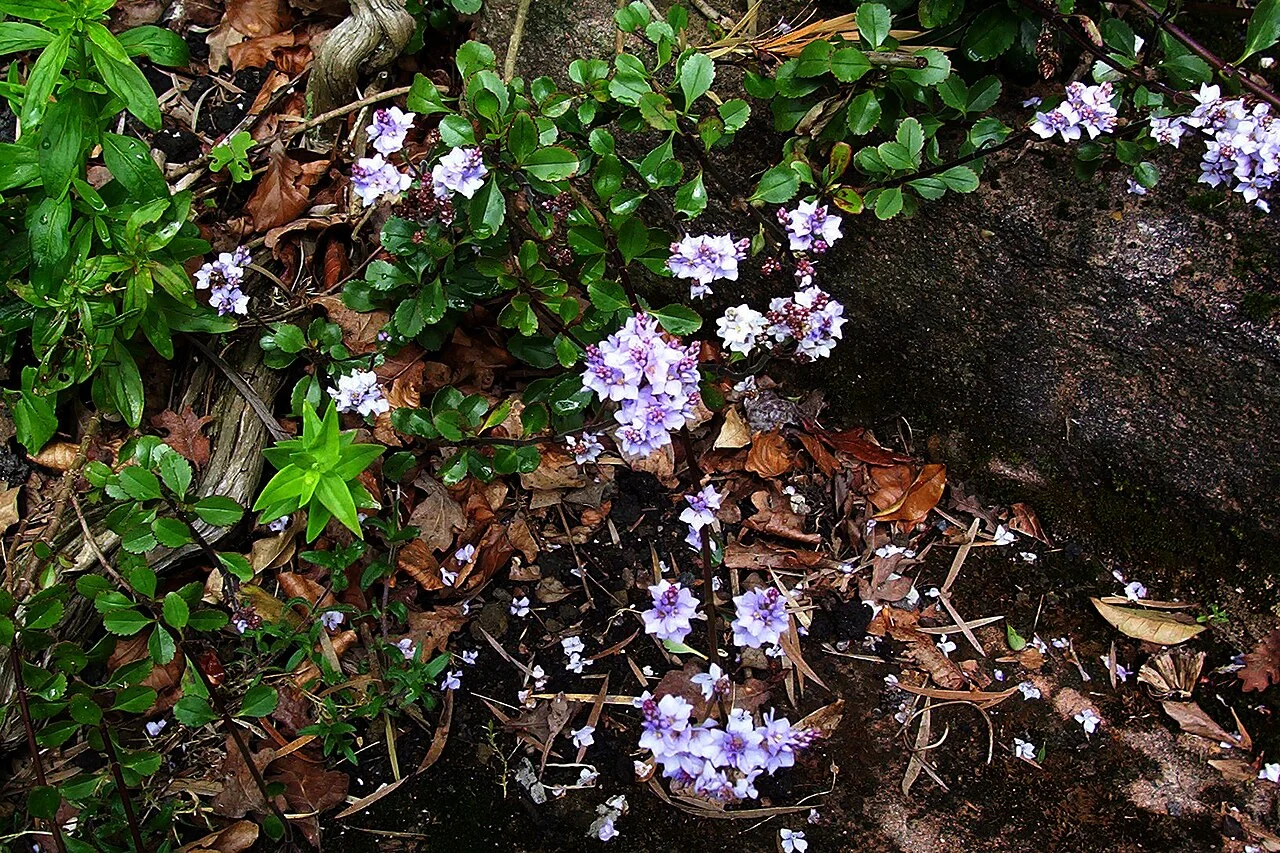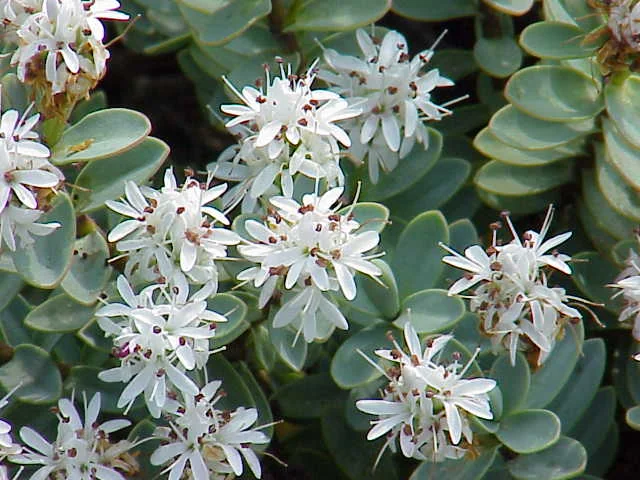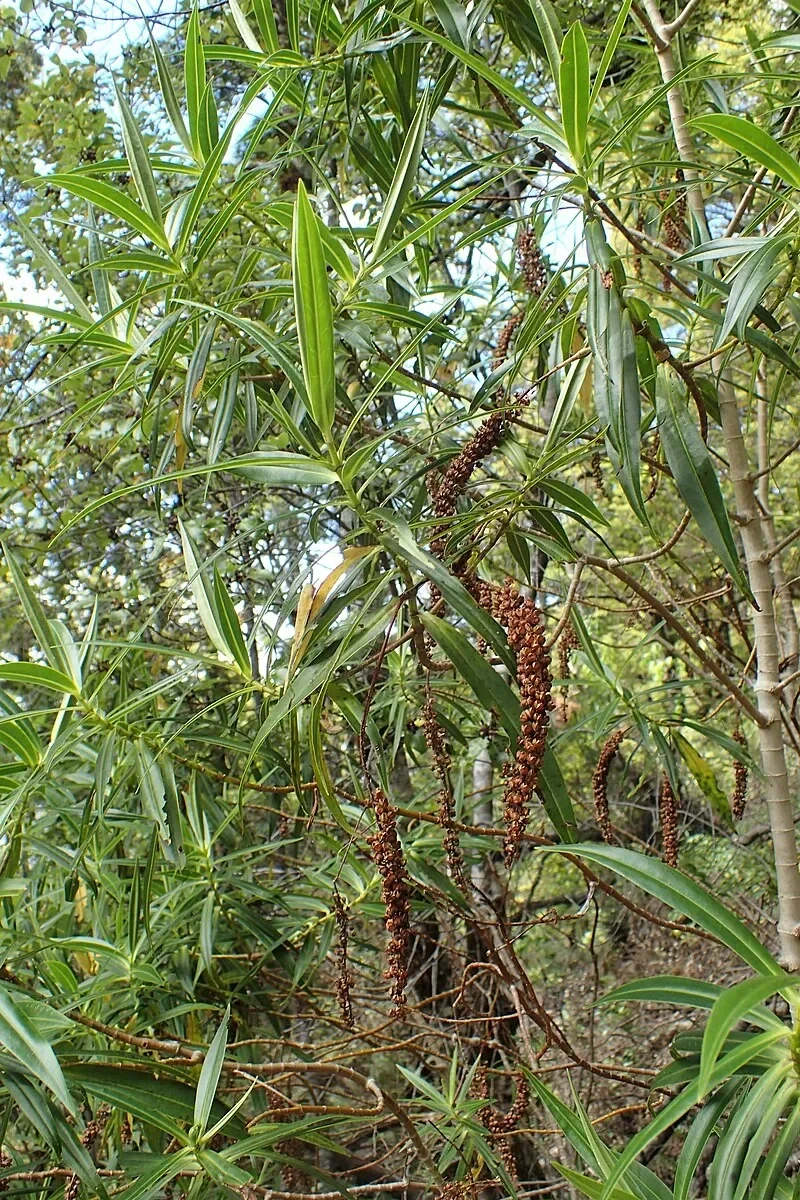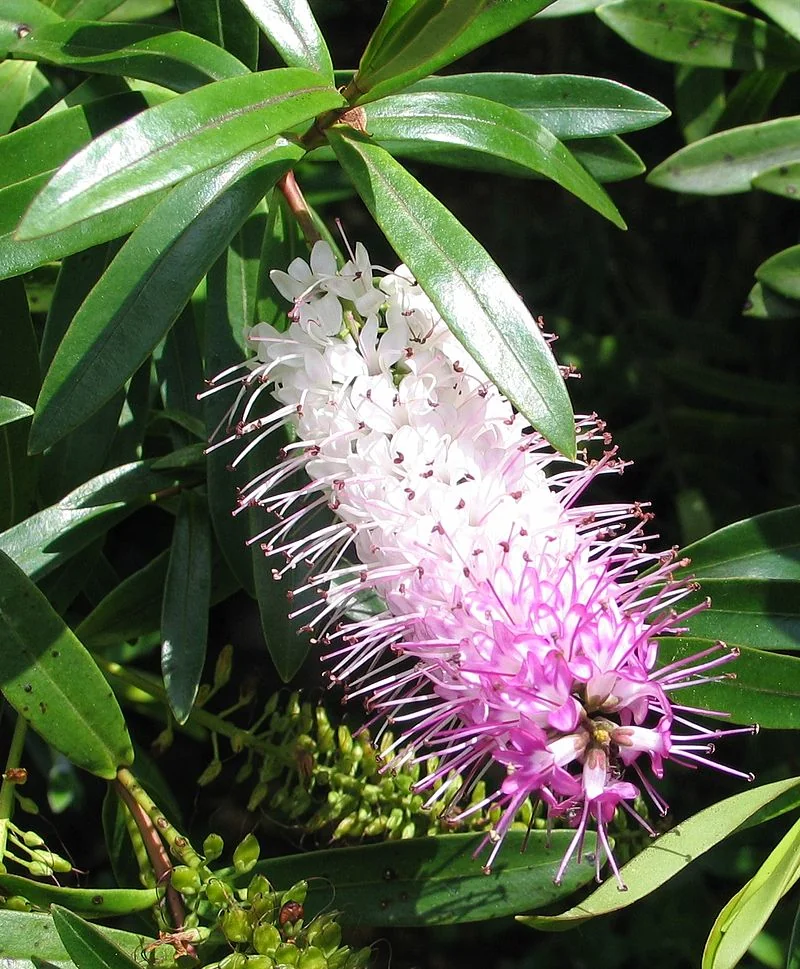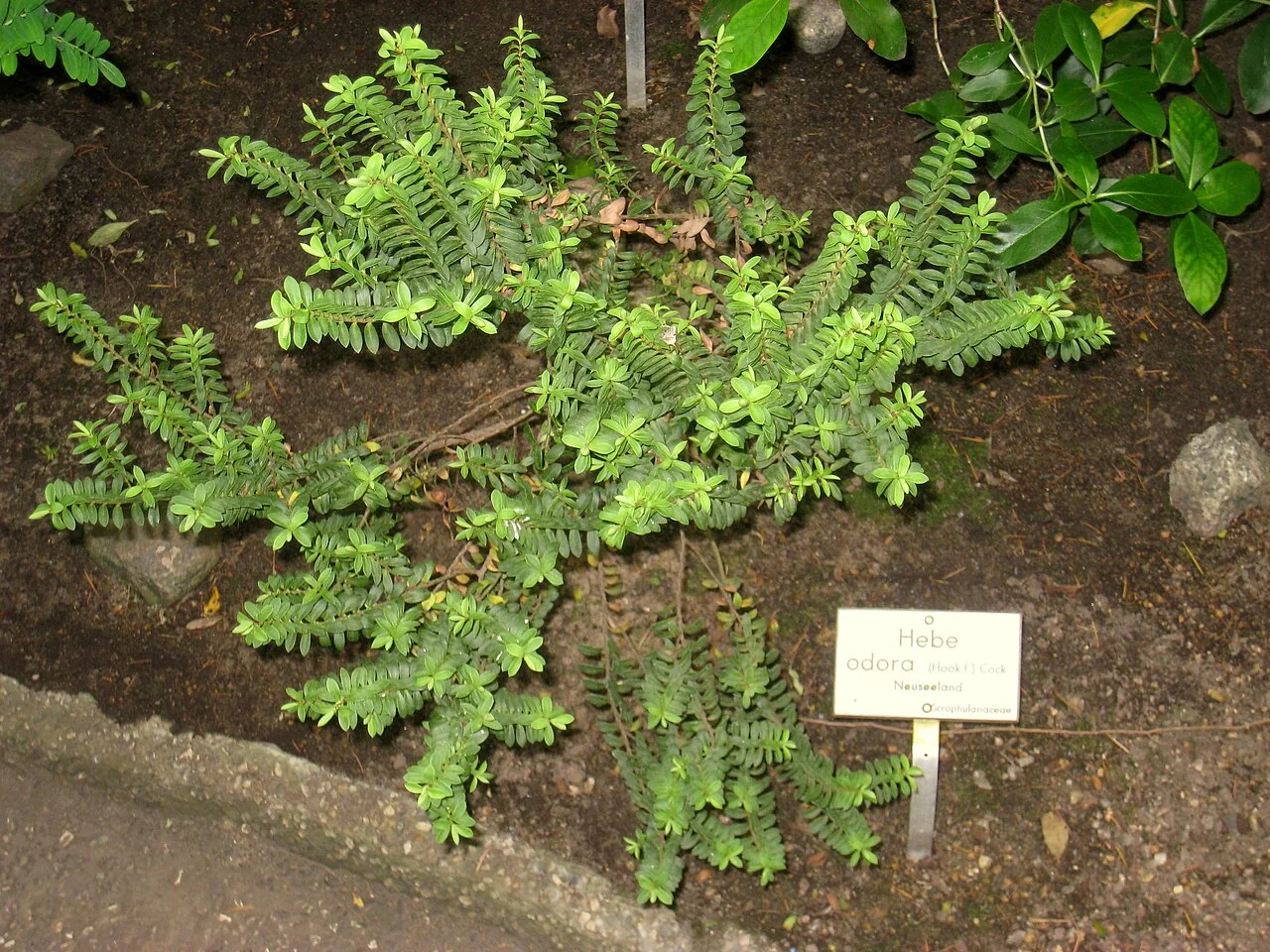
Box-leaf Hebe
Veronica odora
Veronica odora , commonly known as Box-leaf Hebe, is a hardy native New Zealand shrub that forms a distinctive rounded bush growing 50cm to 1 meter tall with small, dark green, box-like leaves. This widespread species inhabits montane to penalpine grassland, shrubland, bogs and flushes throughout the North Island, South Island, Stewart Island and Auckland Islands, typically in wet situations from sea level to 1,672 meters elevation. Known for its loose racemes of white flowers that bloom from spring to autumn, this resilient shrub is highly valued both for its ornamental qualities and its adaptability to diverse growing conditions.

Plant Description
Veronica odora (hebe) is a compact shrub with aromatic foliage when crushed and short spikes of white to pale lilac flowers. Leaves are opposite, glossy, and often slightly glaucous; habit neat and rounded.
Quick Facts
| Common Names | Box-leaf Hebe, Hebe Odora |
|---|---|
| Scientific Name | Veronica Odora |
| Family | Plantaginaceae (Plantain family) |
| Growth Form | Rounded shrub, sometimes mat-forming |
| Height | 50cm - 1.7 m tall (usually shorter) |
| Spread | 60-100cm spreading rounded bush |
| Water Needs | Low to moderate - drought tolerant once established |
| Light | Full sun to partial shade |
| Frost Tolerance | Hardy - tolerates moderate to heavy frosts |
| Salt Tolerance | Good - suitable for coastal conditions |
| Growth Rate | Moderate - slow to establish, then steady growth |
| Lifespan | Long-lived perennial shrub (10+ years) |
| Flowers | White, in loose terminal racemes |
| Flowering Time | November - January (sometimes to March) |
| Conservation Status | Not Threatened |
| Distribution | North Island, South Island, Stewart Island, Auckland Islands |
| Habitat | Montane to penalpine grassland, shrubland, bogs and flushes |
| Elevation Range | Sea level - 1,672 m |
| Cultural Name | Part of the koromiko group (Māori) |
Climate Best Suited to
Cool to mild coastal climates; tolerates wind and light frost; dislikes hot, humid summers and heavy, waterlogged soils.
Regional Suitability
| City | Climate Suitability |
|---|---|
| Whangārei | Ideal |
| Auckland | Ideal |
| Hamilton | Ideal |
| Tauranga | Ideal |
| Rotorua | Ideal |
| Gisborne | Ideal |
| New Plymouth | Ideal |
| Napier | Ideal |
| Whanganui | Ideal |
| Palmerston North | Ideal |
| Wellington | Ideal |
| Nelson | Ideal |
| Christchurch | Ideal |
| Dunedin | Ideal |
| Invercargill | Ideal |
Natural Habitat
Rocky coastal and subalpine habitats depending on form; typically wellÃÃÃà ⬢ÃÃâ¬Ã ⬢ÃÃÃâ¬Ãà áÃÃ⬠¡ÃÃâÃÃÃà ⬢ÃÃ⬠¡ÃÃâÃÃÃÃÃâÃÃÃââ¬Ãà áÃÃìÃÃâ¬Ã¦ÃÃáÃÃÃâ¬Ãà áÃÃ⬠¡ÃÃìÃÃÃà ⬢ÃÃÃâÃâ⬠¡Ãìà à ÃáÃÃÃâ¬Ãà áÃÃ⬠¡ÃÃÃÃÃÃà ⬢ÃÃâ¬Ã ⬢ÃÃÃâ¬Ãà áÃÃ⬠¡ÃÃâÃÃÃà ⬢ÃÃ⬠¡ÃÃâÃÃÃÃÃâÃÃÃââ¬Ãà áÃÃìÃÃâ¬Ã¦ÃÃáÃÃÃâ¬Ãà áÃÃ⬠¡ÃÃìÃÃÃà ⬢ÃÃÃâÃâ⬠¡ÃìÃÃùÃÃÃâ¬ÃÃæÃÃÃâÃâ⬠¡Ãìà à ⬠drained, exposed sites with good air movement.
On limestone pavements and gritty ridges the species thrives, taking full sun with constant wind; emulate these conditions in the garden.
Plant Conservation
Conservation Status
Veronica odora has a conservation status of "Not Threatened" according to the New Zealand Threat Classification System, reflecting its widespread distribution and stable populations throughout New Zealand's mountainous regions.
Ecological Importance
As a widespread montane species, Box-leaf Hebe plays important ecological roles in subalpine and alpine plant communities. The species exhibits fascinating genetic diversity with diploid plants recorded from the North Island, northern South Island and Auckland Islands, while tetraploids occur at various South Island localities and Stewart Island. This chromosomal variation contributes to the genetic richness of New Zealand's flora.
The species commonly hybridizes with whipcord hebes throughout its range, including crosses with V. tetragona in the North Island and V. hectorii in the South Island, helping maintain genetic diversity within the Veronica genus. Its wind-dispersed seeds make it important for natural colonization and ecosystem recovery processes.
How to Grow
Planting Guide
Best Planting Practices
Plant slightly proud in heavy soils; mulch with gravel to keep the collar dry. Space 0.6-1ÃÃÃà ⬢ÃÃâ¬Ã ⬢ÃÃÃâ¬ÃÃà ÃÃÃâÃâ⬠¡ÃìÃâ⬠¾ÃâÃÃÃÃÃâÃÃÃââ¬Ãà áÃÃìÃÃ⬠¡ÃÃÃÃÃÃâ¬ÃÃæÃÃ⬠¡ÃÃáÃÃÃà ⬢ÃÃâ¬Ã ⬢ÃÃÃÃÃâÃÃÃââ¬Ãà áÃÃìÃÃâ¬Ã¦ÃÃáÃÃÃà ⬢ÃÃÃâÃâ⬠¡Ãìà à ÃáÃÃÃâ¬Ãà áÃÃ⬠¡ÃÃà m depending on cultivar size.
Ecology
Flowers provide nectar for pollinators; dense habit offers shelter for small invertebrates.
Compact, nectarâ¬rich flowers feed pollinators early in the season; dense twigging provides shelter for invertebrates and small skinks.
Uses
Compact coastal shrub for borders, low hedges and container culture; aromatic foliage adds sensory interest.
Excellent as a clipped, low partition along paths where brushing releases scent, or as punctuation in gravel gardens with silver foliage companions.
Landscaping Ideas
Contrast with silver Astelia and fine grasses; place along paths for scented brushing.
Position on raised berms or rock pockets where drainage is instant; echo its rounded habit with repeated planting to tie vistas together in windy coastal sites.
Seasonal Care
After Flowering
Light trim to maintain shape and encourage new shoots.
Summer
Keep roots cool with gravel mulch and water deeply during extended drought; avoid overhead irrigation in humid heat.
Pruning
Pruning Techniques
Clip lightly after flowering; avoid cutting into old wood with no foliage.
Renew shape by shortening a portion of older stems each year to a leafy side shoot, keeping the plant compact without exposing bare framework.
How to Grow Box-leaf Hebe
Box-leaf Hebe grows best when you match its natural habitat: prepare wellÃÃÃà ⬢ÃÃâ¬Ã ⬢ÃÃÃâ¬Ãà áÃÃ⬠¡ÃÃâÃÃÃà ⬢ÃÃ⬠¡ÃÃâÃÃÃÃÃâÃÃÃââ¬Ãà áÃÃìÃÃâ¬Ã¦ÃÃáÃÃÃâ¬Ãà áÃÃ⬠¡ÃÃìÃÃÃÃÃâÃÃÃââ¬Ãà áÃÃìÃÃâ¬Ã¹Ã à ⬠drained soil, get the light right, water steadily, and protect from extremes during establishment. Dig wide planting holes, set the crown at original depth, water to settle, and mulch with coarse organic matter to conserve moisture while keeping the stem base dry. Feed lightly in spring; heavy nitrogen is unnecessary and can weaken growth.
Seed
Sow fresh, viable seed on a freeÃÃÃà ⬢ÃÃâ¬Ã ⬢ÃÃÃâ¬Ãà áÃÃ⬠¡ÃÃâÃÃÃà ⬢ÃÃ⬠¡ÃÃâÃÃÃÃÃâÃÃÃââ¬Ãà áÃÃìÃÃâ¬Ã¦ÃÃáÃÃÃâ¬Ãà áÃÃ⬠¡ÃÃìÃÃÃÃÃâÃÃÃââ¬Ãà áÃÃìÃÃâ¬Ã¹Ã à ⬠draining mix, cover lightly with fine grit, and keep evenly moist in bright light out of harsh sun. Germination timing varies; prick out once roots hold the media and harden off gradually.
Division
Where the species permits, divide robust clumps in early spring as new growth begins. Replant divisions with several shoots into fresh mix, water thoroughly, and maintain steady moisture until reÃÃÃà ⬢ÃÃâ¬Ã ⬢ÃÃÃâ¬Ãà áÃÃ⬠¡ÃÃâÃÃÃà ⬢ÃÃ⬠¡ÃÃâÃÃÃÃÃâÃÃÃââ¬Ãà áÃÃìÃÃâ¬Ã¦ÃÃáÃÃÃâ¬Ãà áÃÃ⬠¡ÃÃìÃÃÃÃÃâÃÃÃââ¬Ãà áÃÃìÃÃâ¬Ã¹Ã à ⬠established.
Cuttings
For shrubs and many perennials, strike semiÃÃÃà ⬢ÃÃâ¬Ã ⬢ÃÃÃâ¬Ãà áÃÃ⬠¡ÃÃâÃÃÃà ⬢ÃÃ⬠¡ÃÃâÃÃÃÃÃâÃÃÃââ¬Ãà áÃÃìÃÃâ¬Ã¦ÃÃáÃÃÃâ¬Ãà áÃÃ⬠¡ÃÃìÃÃÃÃÃâÃÃÃââ¬Ãà áÃÃìÃÃâ¬Ã¹Ã à ⬠hardwood cuttings in late spring to summer in a coarse, freeÃÃÃà ⬢ÃÃâ¬Ã ⬢ÃÃÃâ¬Ãà áÃÃ⬠¡ÃÃâÃÃÃà ⬢ÃÃ⬠¡ÃÃâÃÃÃÃÃâÃÃÃââ¬Ãà áÃÃìÃÃâ¬Ã¦ÃÃáÃÃÃâ¬Ãà áÃÃ⬠¡ÃÃìÃÃÃÃÃâÃÃÃââ¬Ãà áÃÃìÃÃâ¬Ã¹Ã à ⬠draining propagation mix under gentle bottom heat and high humidity. Reduce leaf area, ventilate progressively as roots develop, and pot on before planting out.
AfterÃÃÃà ⬢ÃÃâ¬Ã ⬢ÃÃÃâ¬Ãà áÃÃ⬠¡ÃÃâÃÃÃà ⬢ÃÃ⬠¡ÃÃâÃÃÃÃÃâÃÃÃââ¬Ãà áÃÃìÃÃâ¬Ã¦ÃÃáÃÃÃâ¬Ãà áÃÃ⬠¡ÃÃìÃÃÃÃÃâÃÃÃââ¬Ãà áÃÃìÃÃâ¬Ã¹Ã à ⬠care
Maintain an open mulch, irrigate during drought in the first season, and prune or tidy according to the species to build a resilient framework. Adjust shade, wind exposure and watering to prevent stress, and refresh mulch annually for longÃÃÃà ⬢ÃÃâ¬Ã ⬢ÃÃÃâ¬Ãà áÃÃ⬠¡ÃÃâÃÃÃà ⬢ÃÃ⬠¡ÃÃâÃÃÃÃÃâÃÃÃââ¬Ãà áÃÃìÃÃâ¬Ã¦ÃÃáÃÃÃâ¬Ãà áÃÃ⬠¡ÃÃìÃÃÃÃÃâÃÃÃââ¬Ãà áÃÃìÃÃâ¬Ã¹Ã à ⬠term performance.
Pests and Diseases
Common Problems and Solutions
Good disease resistance; ensure air flow to prevent fungal issues in humid summers.
Root rot arises in saturated soils; plant on a slight mound, and thin lightly if congestion traps humidity within the crown.
Cultural Significance
Traditional Uses and Values
Box-leaf Hebe belongs to the broader group of plants known collectively as "koromiko" in te reo Māori, a name that encompasses various Hebe and Veronica species throughout New Zealand. While specific traditional uses of Veronica odora are not extensively documented, its close botanical relationship to other koromiko species suggests it likely shared similar cultural importance.
Related koromiko species were extensively used in rongoā (traditional Māori medicine), with leaves commonly chewed to treat dysentery and diarrhea, and used as poultices for ulcers and wounds. The broader koromiko group was considered particularly beneficial for kidney and bladder health, and as a general tonic.
During both World Wars, dried koromiko leaves were famously sent to New Zealand soldiers overseas, with Māori communities organizing to provide this traditional medicine to their men serving abroad. This practice demonstrated the ongoing cultural significance and practical value of these native plants.
Today, Box-leaf Hebe represents an important part of New Zealand's botanical heritage and serves as an excellent example of the country's endemic flora. Its widespread cultivation in gardens worldwide has made it one of New Zealand's most recognizable native plant ambassadors.
Bonus Tip
Expert Growing Advice
Gravel mulch at the base keeps the collar dry through winter wet.
In frost-prone hollows, place near sun-warmed stone to buffer cold snaps while preserving the crisp, compact habit.
